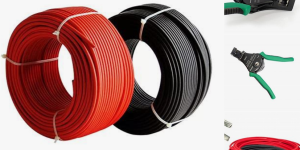When it comes to harnessing the power of the sun, we often think of the big, shiny solar panels that adorn rooftops and fields. But there’s a crucial component in the solar energy system that’s often overlooked: the PV cables, or solar cables as they’re sometimes called. These unsung heroes are the veins and arteries that carry the lifeblood of solar energy from the panels to the places where it’s needed most. But, as with any hero, there’s a cost to consider, and the economics of PV cables are a fascinating blend of cost and efficiency. Let’s dive into this often-overlooked aspect of solar energy systems.
The Role of PV Cables in Solar Energy Systems
PV cables are the workhorses of solar energy systems. They’re responsible for transmitting the electrical current generated by solar panels to inverters, batteries, or the electrical grid. Without them, those panels would be nothing more than expensive decorations. The quality and efficiency of these cables directly impact the performance and longevity of the entire solar system.
Imagine a solar panel working at peak efficiency, soaking up the sun’s rays and converting them into electricity. Now, picture that electricity trying to travel through a subpar PV cable. The cable’s resistance can lead to energy loss, reducing the overall efficiency of the system. That’s why choosing the right PV cable is crucial for maximizing the return on investment in a solar energy system.
Materials and Types of PV Cables
PV cables are made from materials that can withstand the harsh outdoor conditions they’re often exposed to. The most common materials used are ethylene propylene rubber (EPR) and polyvinyl chloride (PVC). Both have their pros and cons, but they share a common trait: they’re designed to resist sunlight, moisture, and temperature fluctuations.
EPR cables are known for their flexibility and resistance to UV radiation, making them a popular choice for outdoor installations. PVC cables, on the other hand, are more cost-effective and offer good resistance to chemicals and oils. The choice between EPR and PVC often comes down to the specific needs of the installation and the budget.
Cost Considerations for PV Cables
When it comes to the economics of PV cables, cost is a significant factor. Solar cables are an investment, and like any investment, you want to get the most bang for your buck. The cost of Solar cable can vary widely depending on the material, length, and the manufacturer.
It’s tempting to go for the cheapest option to save on upfront costs, but this can lead to problems down the line. Cheaper cables may not have the same durability or resistance to environmental factors, leading to a shorter lifespan and higher replacement costs. On the other hand, investing in higher-quality PV cables can result in long-term savings due to their increased durability and efficiency.
Efficiency and Longevity of PV Cables
Efficiency is not just about the initial cost; it’s also about how well the PV cables perform over time. High-quality solar cables can reduce energy loss due to their lower resistance, which means more of the electricity generated by the solar panels makes it to its destination. This can lead to a more efficient solar energy system and a better return on investment.
Longevity is another aspect of efficiency. A PV cable that lasts longer means fewer replacements and less downtime for the solar system. This is especially important in remote or hard-to-reach locations where replacing a cable can be a costly and time-consuming process.
Balancing Cost and Efficiency
Balancing the cost and efficiency of PV cables is all about making informed decisions. It’s not just about choosing the cheapest option; it’s about choosing the option that offers the best value for money. This involves considering the total cost of ownership, including the initial cost, maintenance, and replacement costs over the lifetime of the solar system.
One way to achieve this balance is by looking at the specifications of different PV cables and comparing them. Factors such as temperature ratings, voltage ratings, and resistance to environmental factors should all be considered. By doing so, you can find a cable that meets the needs of your solar system without breaking the bank.
The Future of PV Cables
As solar technology advances, so too does the technology behind PV cables. We’re seeing the development of new materials and designs that promise even greater efficiency and durability. These advancements could lead to even more cost-effective and efficient solar energy systems in the future.
In conclusion, the economics of PV cables are a complex dance of cost and efficiency. By understanding the role of these cables in solar energy systems and making informed decisions about the materials and types of PV cables, we can ensure that our solar systems are as efficient and cost-effective as possible. So, the next time you look at a solar panel, don’t forget to give a nod to the humble PV cable – it’s a silent partner in the quest for clean, renewable energy.











